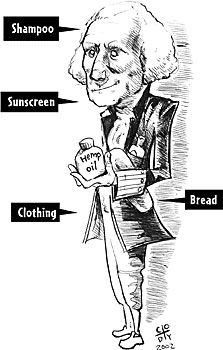
Illustration by Cody Angell
|
By Jessica Lee
Arizona Daily Wildcat
Thursday November 14, 2002
The United States is lagging behind the current trend of industrial hemp production. More than 25 countries rack in nearly $1 billion a year from the sale of hemp-based products. Due to the marijuana ban of 1937, U.S. farms have been prohibited from growing the crop that both George Washington and Thomas Jefferson avidly cultivated.
For starters, let's make it clear that hemp is not marijuana. According to Hemptech, the Industrial Hemp Information Network, Marijuana contains 3-15 percent of the psychoactive chemical delta-9 tetrahydrocannabinol (THC). Its distant cousin, hemp, only has one percent or less THC. Hemp has never been grown for any psychoactive affects, but rather for its fiber. Even if one smoked 100 hemp cigarettes, they would experience no euphoric effects.
Hemp production ceased in the United States when lobbyists for petroleum, timber, cotton and alcohol persuaded Congress that marijuana was "the devil's weed with roots in hell."
The mid-1930s was witness to new technologies that would make industrial hemp a competitor with the newly created plastics and synthetic fiber industries. In order to boost sales of the re-legal booze, the alcohol industry helped intensify the scare with its funded movie "Reefer Madness."
And with the liquor prohibition over, the deep cut in funding for the Federal Bureau of Narcotics (the Drug Enforcement Agency) also contributed to the anti-hemp campaign. By creating a new "evil drug," FBN personnel pockets would be filled with federal tax dollars.
Due to the red tape that was created by the myth-based Marihuana Tax Act of 1937, cultivating industrial hemp became nearly impossible.
In a time when the environmental and health effects of petroleum-based products are becoming more prevalent and the United States is threatening to go to war over access to oil, it is an appropriate time to advocate the reintroduction of hemp production. "The marketplace, not myopic rules, should determine hemp's future in America," read an April 1998 New York Times editorial.
Hemp is the ultimate renewable resource. It grows to a height of six to 16 feet in approximately 100 days, does not require pesticides, and because its dense growth reduces weed accumulation, it does not need herbicides. Due to the technological breakthroughs, 95 percent of the hemp plant can be used for manufacturing a wide range of materials. These plant parts include fiber and hurds (the core of the stem) from the stalk, seeds, seed oil and seed cake (crushed seed).
Over 25,000 products can be made from processed industrial hemp. "We are beginning to recognize that these (agricultural crops) are renewable materials that can be used in a vast area of industrial products from plastics to lubricants," says Robert Armstrong of the USDA Alternative Agricultural Research and Commercialization Center. An October 26, 1994 article in The London Financial Times stated, ". . . fibre hemp . . . is making a comeback in Europe and the U.S. as an ecologically friendly raw material for clothing and paper."
Here is a brief overview of some hemp-based products:
Body Care
Shampoo, conditioner, soaps, lotions, lip balms, sunscreen, shower gel, eye and face cream and massage oils are some of the most popular cosmetic products based on hempseed oil.
These natural oils help our body's natural ability to heal. These hemp-based products can be found at Wild Oats in Tucson or through various companies on-line such as Azida Inc., based in Sierra Vista.
Foodstuffs
Hemp seed can be made into hundreds of food products. The seed is high in calcium, magnesium, phosphorus, protein, potassium and vitamin A. The seeds can be soaked, ground or crushed in order to remove the oils.
The leftover seed cake can then be used as flour for making pastas, cookies, cakes, and high-quality breads. Nondairy products such as milk, ice cream and cheese can also be derived from the seed. Some hemp-based foods can be found at Trader Joe's.
Paper
Until the beginning of the 20th century, the entire world depended on paper made from hemp fiber. Growth time for trees is 50-500 years, when hemp could be harvested three times a year.
The long fibers are ideal for high quality papers ÷ they resist age-caused yellowing of wood-based papers ÷ and can be recycled several times more.
Other important products such as paints, sealants, insulation, plastics, pharmaceuticals, textiles, automotive materials and fuels, clothing, composites and feed can be derived from the hemp plant.
The only way hemp products can make a comeback without legalizing marijuana is if consumers demand them.
It is time we incorporate consumer responsibility into our daily habits by supporting items that are less environmentally destructive.

